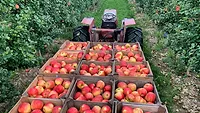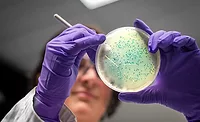Study Examines Listeria, Salmonella Survival in Dry Packaging Facilities, Efficacy of Sanitizers

Credit: Mark Stebnicki (nc-farm-bureau-mark) via Pexels
An ongoing study funded by the Center for Produce Safety (CPS) is examining the survival of Salmonella and Listeria monocytogenes on surfaces in dry food packaging facilities, as well as the efficacy of dry cleaning processes on pathogen reduction. The study, led by Clemson University researchers Paul Dawson, Ph.D., and Kay Cooksey, Ph.D., aims to improve produce safety by identifying and investigating critical areas for microbial risk that exist in packinghouse environments after the washing, waxing, and drying steps.
Dr. Dawson chose to focus on Salmonella and L. monocytogenes due to their prevalence in produce packaging facilities, as well as their differing physiological characteristics. For instance, packaging facilities issued recalls for stone fruits contaminated with L. monocytogenes and peaches contaminated with Salmonella in 2016 and 2020, respectively. Additionally, while Salmonella is resistant to drying and can persist on surfaces with low water activity, L. monocytogenes survives and grows under cool, damp conditions. Salmonella can still survive in lower temperatures, but its growth is inhibited.
The study will be conducted in three parts, the first of which has concluded. During the first objective, the researchers simulated packinghouse conditions using discs cuts from dry surfaces within a packaging facility, which were inoculated with planktonic pathogen cells or biofilms formed on dry surfaces. The cells and biofilms were naturally occurring, collected from surface swab samples from two California Central Valley peach packinghouses. The researchers then evaluated how quickly the microbes died under various environmental conditions that are common to packaging facilities.
The researchers found that simply drying a surface does not necessarily affect microbes that may be persisting on it, and believe that the pathogens’ die-off patterns suggest the ability of microorganisms to adapt to dry conditions. When the planktonic cells were stored at 25 degrees Celsius (77 degrees Fahrenheit) at 60 percent or 85 percent humidity, the pathogens survived for only a few hours. However, the cells were able to survive much longer at 20 percent humidity.
Additionally, when examining the effects of three commercial coatings applied to reduce fruit respiration and extend shelf life, the researchers found that the coatings increased survival for both L. monocytogenes and Salmonella planktonic cells. A similar effect was noted for the presence of organic matter, which can be found in wash water.
However, dried biofilms were able to survive several days under high humidity, but could not persist under low humidity. Dr. Dawson states that this finding reinforces the importance of cleaning and sanitizing dry areas to prevent microbial attachment and biofilm formation.
To analyze the dry biofilms while reducing the likelihood of false negative results, Dr. Dawson’s team is using multiple methods: plate counts, microscopy, and real-time polymerase chain reaction (PCR). When microbes experience stress, such as dry environments, they enter a “viable, but non-culturable” (VBNC) survival mode, which renders the pathogenic microorganisms undetectable using traditional cultural methods. Moving forward, the researchers will examine conditions that cause planktonic cells to form biofilms.
The next stage of the study will involve the evaluation of various food-grade sanitizers’ efficacy against dried planktonic cells and dried biofilms under lab-simulated dry packaging conditions. In the third and final stage, the researchers will validate their findings in a packinghouse pilot plant. Dr. Dawson shared his hopes that the study’s final results will help identify strategies to reduce the presence of pathogens in dry environments. The study, which began in January 2022, is expected to be completed by the end of 2022.
Looking for quick answers on food safety topics?
Try Ask FSM, our new smart AI search tool.
Ask FSM →









